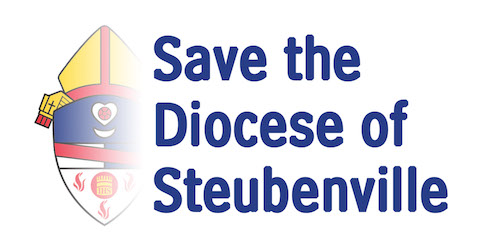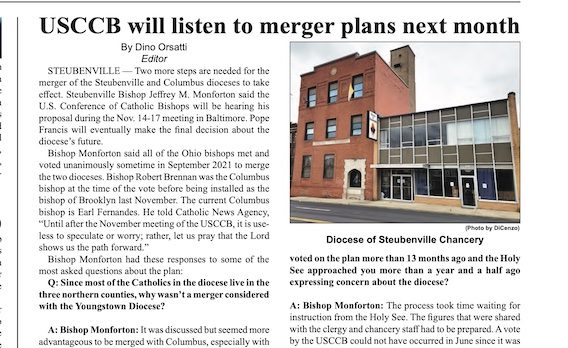In the issue of the Steubenville Register released earlier today the first article is, naturally, about the proposed suppression of the Diocese of Steubenville. The article has some information about the coming procedure — the bishops of the U.S. will vote during their USCCB meeting from November 14-17 — but this procedural information is followed by a Q and A with Bishop Monforton.
Here are the relevant questions, with my commentary/reply:
Q: Since most of the Catholics in the diocese live in the three northern counties, why wasn’t a merger considered with the Youngstown Diocese?
A: Bishop Monforton: It was discussed but seemed more advantageous to be merged with Columbus, especially with the location of the priests in the Steubenville Diocese.
Advantageous how? Youngstown is closer, and has more in common, culturally and historically, with Steubenville than does Columbus. Also, since the majority of the Catholics in the Diocese of Steubenville are in the northern three counties — those closest to Youngstown — wouldn’t there be more priests in these counties? So then again, wouldn’t that suggest Youngstown would be a better fit, at least for these three counties?
Q: What is the status of the diocesan schools and capital improvement projects that are taking place?
A: Bishop Monforton: Everything continues forward with no delays.
For now… But the Bishop of Columbus is not bound by any decisions made by the Bishop of Steubenville once the merger takes place. Naturally, any contracts entered into by the business entity of the Diocese of Steubenville would be assumed by the business entity of the Diocese of Columbus, but promises to pastors or the school board of Steubenville would not be binding on the Bishop of Columbus.
And as that bishop will have to consider the needs of all 36 counties of his diocese, the odds are some of the promises made by the defunct bishopric of Steubenville will not be honored.
Q: What is the purpose of the survey that parishioners are being asked to fill out?
A: Bishop Monforton: This information will be compiled and shared with the USCCB next month.
OK, so I suppose we should fill it out. But be sure to be clear in the few areas where you can enter text that this is merger not welcome, nor is it necessary. And be sure to fill out this better, more comprehensive survey put together by some lay faithful also.
Q: Why did you inform the clergy and chancery staff about the merger plans on Oct. 10 when the Ohio bishops voted on the plan more than 13 months ago and the Holy See approached you more than a year and a half ago expressing concern about the diocese?
A: Bishop Monforton: The process took time waiting for instruction from the Holy See. The figures that were shared with the clergy and chancery staff had to be prepared. A vote by the USCCB could not have occurred in June since it was a special session and voting was prohibited then.
First: Whoa, what? The Holy See approached him about this? And more than 18 months ago? The language used in the Crux article indicated that the topic had come up in conversation with the Vatican, but the Vatican’s job is to discuss matters of concern with bishops. If it’s one of a number of topics raised during a regular conversation, like during an ad limina visit, that’s one thing. But if the Vatican went out of its way to raise the matter with Bishop Monforton, out of the blue, that’s altogether different. Clarification on this point seems… important. [I edited this paragraph to reflect what a friend pointed out about the text in the Crux article, which hadn’t jumped out to me, because it didn’t seem as remarkable as “they approached me” is.]
Second, the response here is all about how the process was initiated and carried out within the hierarchy of the Church, and since no figures were ready to share with anyone, no one at the chancery (let alone the clergy or the lay faithful) could be brought into the conversation.
I suppose we should be happy that the USCCB meeting in June didn’t allow votes, or we would have woken up in late June to find out that we’d been suppressed over night!
Very synodal. So much listening. Wow.
Q: What do you say to clergy, parishioners and chan- cery staff who do not agree with the merger proposal and want the diocese to remain independent?
A: Bishop Monforton: Fill out the survey and let your opinion be heard.
So, nothing. You say nothing but “go ahead and voice your opinion.”
Zero attempt to be pastoral, just “fill out the survey.” OK.
Diocese mergers are not common. The most recent U.S. diocese merger was in 2020, when the Diocese of Juneau, Alaska, was merged with the Archdiocese of Anchorage to create the Archdiocese of Anchorage-Juneau. The last merger before that occurred in 1956, when the Diocese of Kansas City and St. Joseph merged to form the Diocese of Kansas City-St. Joseph.
As I explained before, neither of those mergers reflects our situation. Also, in both of those cases, the see that was diminished (Jueau and St. Joseph, respectively), remained a co-see city. The resultant dioceses are The Diocese of Kansas City-St. Joseph, and the Archdiocese of Anchorage-Juneau. Those two cities retained a co-cathedral, they were not completely suppressed as is the intention here.
That’s a difference, and not a small one.
But this issue of the Steubenville Register has another article or two to write about, so as I say: more to come.

